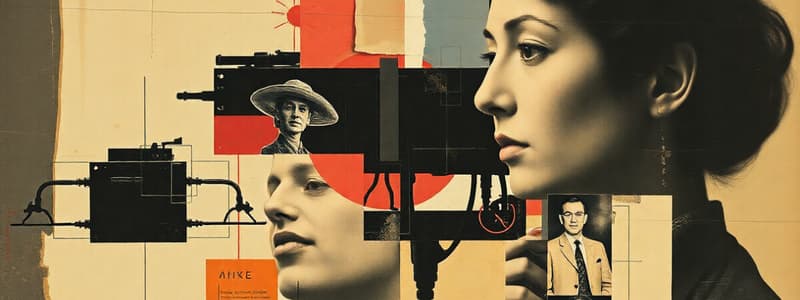Podcast
Questions and Answers
What primary focus does New Criticism emphasize in literary analysis?
What primary focus does New Criticism emphasize in literary analysis?
- Historical context of the authors
- Comparative analysis with other literary works
- Examining biographical details
- Close reading of the text (correct)
Which book is considered a significant source for the name 'New Criticism'?
Which book is considered a significant source for the name 'New Criticism'?
- The New Criticism (correct)
- Practical Criticism
- The Principles of Literary Criticism
- The Meaning of Meaning
Which of the following concepts did W.K. Wimsatt and Monroe Beardsley introduce?
Which of the following concepts did W.K. Wimsatt and Monroe Beardsley introduce?
- Intentional and affective fallacy (correct)
- The importance of authorial intent
- The role of historical context
- The value of empirical science in literature
In addition to Ransom, which scholar is noted for significant contributions to New Criticism's methodology?
In addition to Ransom, which scholar is noted for significant contributions to New Criticism's methodology?
Which poet's theories significantly influenced the New Critical canon?
Which poet's theories significantly influenced the New Critical canon?
Which approach did New Criticism react against?
Which approach did New Criticism react against?
What is one aspect that New Criticism tends to neglect according to its principles?
What is one aspect that New Criticism tends to neglect according to its principles?
Which of the following terms is linked to T.S. Eliot's discussions in his essays related to New Criticism?
Which of the following terms is linked to T.S. Eliot's discussions in his essays related to New Criticism?
Which literary form did New Criticism primarily emphasize in its close reading approach?
Which literary form did New Criticism primarily emphasize in its close reading approach?
What is the main goal of examining a text through the lens of New Criticism?
What is the main goal of examining a text through the lens of New Criticism?
What did the New Critics aim to exclude from their analysis of literary texts?
What did the New Critics aim to exclude from their analysis of literary texts?
Which concept did Wimsatt and Beardsley argue against in their writings?
Which concept did Wimsatt and Beardsley argue against in their writings?
Which method became a staple of New Criticism in literary studies?
Which method became a staple of New Criticism in literary studies?
Who articulated the goals of New Criticism through notable essays?
Who articulated the goals of New Criticism through notable essays?
Which aspect was NOT a focus of the New Criticism?
Which aspect was NOT a focus of the New Criticism?
Which of the following was a result of New Criticism's influence?
Which of the following was a result of New Criticism's influence?
New Critics viewed the relationship between a text's structure and its meaning as:
New Critics viewed the relationship between a text's structure and its meaning as:
The New Critics primarily sought to reorient literary studies towards:
The New Critics primarily sought to reorient literary studies towards:
What is a primary criticism of the New Criticism approach?
What is a primary criticism of the New Criticism approach?
Cleanth Brooks argues that emphasizing the reader in literary criticism might lead to what issue?
Cleanth Brooks argues that emphasizing the reader in literary criticism might lead to what issue?
Which of the following goals do New Critics aim to achieve through their methodology?
Which of the following goals do New Critics aim to achieve through their methodology?
Which theory is frequently contrasted with New Criticism?
Which theory is frequently contrasted with New Criticism?
Which of the following texts is NOT associated with the New Critics?
Which of the following texts is NOT associated with the New Critics?
Which of the following is characteristic of the New Criticism methodology?
Which of the following is characteristic of the New Criticism methodology?
Flashcards
New Criticism
New Criticism
A formalist movement in literary theory focusing on close reading of texts, especially poetry, to analyze aesthetic qualities and self-referential meaning.
Formalism
Formalism
Literary theory emphasizing the form and structure of a work, rather than its historical context or author's intentions.
Close Reading
Close Reading
Careful analysis of a text to understand its structure, imagery, and language.
Intentional Fallacy
Intentional Fallacy
Signup and view all the flashcards
Affective Fallacy
Affective Fallacy
Signup and view all the flashcards
Immediacy of Meaning
Immediacy of Meaning
Signup and view all the flashcards
Aesthetic Qualities
Aesthetic Qualities
Signup and view all the flashcards
Self-Contained
Self-Contained
Signup and view all the flashcards
Literary History
Literary History
Signup and view all the flashcards
Empirical Approach
Empirical Approach
Signup and view all the flashcards
New Criticism's Goal
New Criticism's Goal
Signup and view all the flashcards
New Critics vs. Literary Appreciation
New Critics vs. Literary Appreciation
Signup and view all the flashcards
What did New Critics value?
What did New Critics value?
Signup and view all the flashcards
What is close reading?
What is close reading?
Signup and view all the flashcards
New Criticism's Legacy
New Criticism's Legacy
Signup and view all the flashcards
New Criticism's Influence
New Criticism's Influence
Signup and view all the flashcards
New Criticism's Rise
New Criticism's Rise
Signup and view all the flashcards
New Criticism's Aim
New Criticism's Aim
Signup and view all the flashcards
Autonomous Text
Autonomous Text
Signup and view all the flashcards
Reader-Response Theory
Reader-Response Theory
Signup and view all the flashcards
Unconscious Signification
Unconscious Signification
Signup and view all the flashcards
Ideology of Liberal Humanism
Ideology of Liberal Humanism
Signup and view all the flashcards
Objective Science in Criticism
Objective Science in Criticism
Signup and view all the flashcards
New Criticism's Response to Reader-Response
New Criticism's Response to Reader-Response
Signup and view all the flashcards
Limitations of Reader-Response
Limitations of Reader-Response
Signup and view all the flashcards
Feminist Theory
Feminist Theory
Signup and view all the flashcards
Post-Colonial Theory
Post-Colonial Theory
Signup and view all the flashcards
Textual Autonomy
Textual Autonomy
Signup and view all the flashcards
Study Notes
New Criticism Overview
- A formalist movement in literary theory that dominated American literary criticism in the mid-20th century.
- Emphasized close reading of literary works, especially poetry, viewing them as self-contained aesthetic objects.
- Developed in reaction to older philological and literary history approaches. These focused on the history of words, their relation to other languages, and authors' biographies, which critics believed distracted from the text's aesthetics.
Key Figures and Influences
- John Crowe Ransom: Author of "The New Criticism" and influential in the movement's development.
- I. A. Richards: A Cambridge scholar whose work on literary criticism and the meaning of language impacted the New Critical methodology.
- Cleanth Brooks, John Crowe Ransom, W. K. Wimsatt, and Monroe Beardsley: Major contributors.
- T. S. Eliot: His essays' concepts of "impersonality" and "objective correlative" were influential. His judgments on other poets were a part of the forming of the New Critical canon.
Core Principles
- Close Reading (Explication de texte): Careful scrutiny of the text's formal elements—rhyme, meter, setting, characterization, plot—to uncover meaning and theme.
- Focus on the Text Itself: Analysis avoided external factors like authorial intent, historical or cultural context, and reader response.
- Emphasis on Structure and Meaning: These were seen as interconnected, not separate.
- Rejection of "Intentional Fallacy" and "Affective Fallacy": Criticized analyzing a work based on the author's intent or a reader's emotional response as invalid methods.
Key Texts
- I. A. Richards: Practical Criticism, Principles of Literary Criticism, The Meaning of Meaning.
- William Empson: Seven Types of Ambiguity.
- T. S. Eliot: Essays "Tradition and the Individual Talent," "Hamlet and His Problems."
- John Crowe Ransom: Essays "Criticism, Inc.," "The Ontological Critic."
- Allen Tate: Essay "Miss Emily and the Bibliographer."
- Wimsatt and Beardsley: Essays "The Intentional Fallacy," "The Affective Fallacy."
- Cleanth Brooks: The Well Wrought Urn: Studies in the Structure of Poetry.
- Robert Penn Warren: Essay "Pure and Impure Poetry."
- Wellek and Warren: Theory of Literature.
Criticism of New Criticism
- Treated texts as autonomous, disregarding historical context.
- Considered uninterested in literature's human meaning, social function, and effect.
- Viewed as attempting to make literary criticism resemble an objective science.
- Critics argued the focus on the writing detached it from its creator; the reader and their reaction to the text is a fundamental part of "experiencing" a poem or novel
Lasting Impact and Legacy
- Some New Critical methods, like close reading, remain central to literary criticism.
- Influenced subsequent theoretical approaches such as poststructuralism, deconstruction, and reader-response theory.
- Anticipated insights of linguistic theory.
- Shown ideological and historical parallels with logical positivism.
Studying That Suits You
Use AI to generate personalized quizzes and flashcards to suit your learning preferences.




